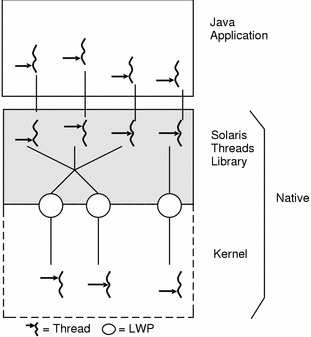Many-to-Many Model (Java on Solaris--Native Threads)
The many-to-many model (many user-level threads to many kernel-level threads) avoids many of the limitations of the one-to-one model, while extending multithreading capabilities even further. The many-to-many model, also called the two-level model, minimizes programming effort while reducing the cost and weight of each thread.
In the many-to-many model, a program can have as many threads as are appropriate without making the process too heavy or burdensome. In this model, a user-level threads library provides sophisticated scheduling of user-level threads above kernel threads. The kernel needs to manage only the threads that are currently active. A many-to-many implementation at the user level reduces programming effort as it lifts restrictions on the number of threads that can be effectively used in an application.
A many-to-many multithreading implementation thus provides a standard interface, a simpler programming model, and optimal performance for each process. The Java on Solaris operating environment is the first many-to-many commercial implementation of Java on an MT operating system.
Figure 2-3 Many-to-Many Multithreading Model

- © 2010, Oracle Corporation and/or its affiliates
